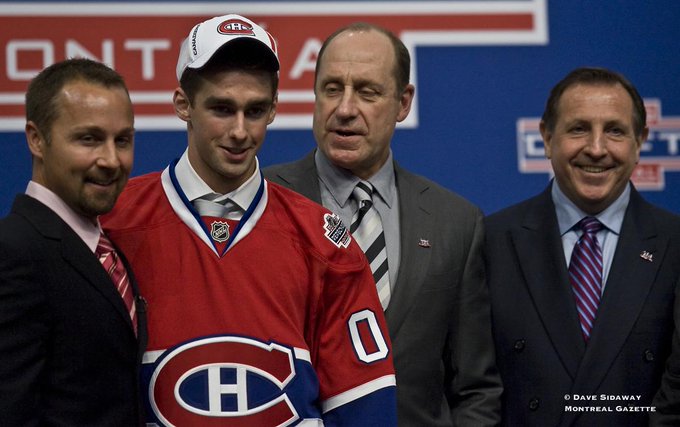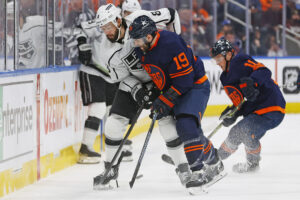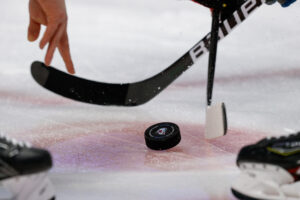NHL player development seems to always result in more questions than answers. How likely is it for a top pick to pan out? What makes a player a “steal”? Last Word On Hockey will be starting a new series on how to properly develop prospects from all different spots throughout the draft. This week’s piece involves draft picks in the back half of the first round and how they were used early in their careers.
NHL Player Development Of First-Round Picks
In the span of 2005 through 2015, there were 84 total selections made between 16th overall and 30th overall on forwards playing in North America. Looking at all 84 forwards, they were split into different categories. Those categories were “Forwards Deemed NHL-Ready and Brought In Immediately When Ready,” “Forwards Near NHL-Ready and Brought In Immediately When Near-Ready,” “Forwards Rushed Slightly,” “Forwards Rushed,” “Forwards Forced,” “A Little Patience,” “Patience,” and “Too Much Patience.”
There were 16 forwards who fell into the fourth category, “forced,” on the list. Of those 16 players, six made their NHL impacts in their DY+3 seasons. Those players are Louis LeBlanc, Kyle Palmieri, Jack Roslovic, Nicklas Jensen, Carter Ashton, and Rickard Rakell. Today, let’s look at LeBlanc and Palmieri.
In this piece, we will be using stats from eliteprospects (raw stats) and hockey-reference (ice time). Additionally, the analytics we are using are as follows: even-strength offence goals above replacement (EVO), even-strength defence goals above replacement (EVD), wins above replacement (WAR) and goals above replacement (GAR). Those analytics are from evolving-hockey (subscription required).
NHL Player Development Of Louis LeBlanc
LeBlanc, drafted 18th overall by the Montreal Canadiens in the 2009 NHL draft, came out of the Omaha Lancers organization of the USHL. In his DY-1 season, however, he played in the QMAAA with the Lac St-Louis Lions. With them, he scored 54 goals and 37 assists for 91 points in 43 games, for 2.116 points per game. That ranked fourth amongst the aforementioned 84 forwards in DY-1 production, albeit in a weaker league than most. The following year, in the USHL, he scored 28 goals and 31 assists for 59 points in 60 games, for 0.983 points per game. That ranked 62nd among those same 84 forwards, in DY production.
After being drafted, LeBlanc would play one season in the NCAA with Harvard University and one season in the QMJHL with the Montreal Juniors. In his NCAA season, he scored 11 goals and 12 assists for 23 points in 31 games, for 0.742 points per game. That ranked 62nd among the 82 forwards in DY+1 production. Joining the QMJHL the next year, LeBlanc scored 26 goals and 32 assists for 58 points in 51 games, for 1.137 points per game. That ranked 22nd out of the 70 forwards still outside of the NHL in DY+2 production. LeBlanc would make the jump to the NHL ranks the following season.
How Was LeBlanc Used
LeBlanc would split between the NHL and AHL in his first professional season. In the AHL, he would score 11 goals and assists for 22 points in 31 games. Meanwhile, LeBlanc would slot into the NHL lineup with Montreal for 42 games. In that span, he would also average 11:12 time on ice per game. In that role, he scored five goals and assists for 10 points. A modest stat line considering the role, and his analytics painted an even better light on his game. While his EVO (2.0) wasn’t anything special, his EVD (0.9) was strong for a rookie. With those modest even-strength metrics, his WAR (0.2) and GAR (1.2) was where you’d expect them to be. Unimpressive, but solid.
Despite an overall decent, though unimpressive, rookie year, LeBlanc saw regression in year two. But, not regression in his own game at the NHL level. He was actually sent to the AHL and never saw a game at the NHL level in year two. Playing exclusively at the AHL level, he scored just 10 goals and 18 total points across 62 games. That’s a big step down from his production in his first AHL season.
More AHL Time, Less NHL Player Development Progress
In his third professional season, LeBlanc would see most of his time spent at the AHL level. Playing in 70 AHL games, he scored 13 goals and 15 assists for 28 points. How about in the NHL? How long did he play there? Eight games, averaging 9:52 per game, was all he got. He didn’t score a single point, unsurprisingly. But again, LeBlanc’s analytics painted the same story as his rookie season. His EVO (-0.2) regressed, but his EVD (0.9) was still solid, showing strong defensive zone abilities yet again. With those metrics at even strength, his WAR (0.1) and GAR (0.5) were unimpressive, but above replacement level.
Embed from Getty Images
Since that third season, in 2013-14, LeBlanc would play just one more season in North America. That season was spent at the AHL level, scoring 29 points in 71 games. In 2015-16, LeBlanc left for Europe, playing in three different leagues in one year. Those leagues were the KHL (Russia), Slovakia, and NLA (Switzerland). He scored a combined five points in 15 games through those leagues. LeBlanc has not played professionally since that 2015-16 season. The NHL player development of LeBlanc clearly did not go well. Getting buried in the AHL after a moderate rookie season is a negative development pattern. However, it’s a lot deeper than just that. But, that’s a story for another time.
NHL Player Development Of Kyle Palmieri
Palmieri, drafted 26th overall by the 2009 NHL draft by the Anaheim Ducks, came out of the US Development Program. In his DY-1 season with the USDP, he played primarily in the NAHL. There, he scored 15 goals and 10 assists for 25 points in 32 games, for 0.781 points per game. That ranked 42nd out of the 84 forwards in DY-1 production. After that season, playing in USDP games (USHL competition and college programs) he scored 14 goals and assists for 28 points in 28 games, for exactly one point per game. That ranked 56th among those same 84 forwards in DY production. Upon getting drafted, Palmieri would play one NCAA season and one AHL season before getting a true NHL shot.
In his freshman NCAA season with the University of Notre Dame, Palmieri scored nine goals and eight assists for 17 points in 33 games, for 0.515 points per game. That ranked 76th out of the 82 forwards still outside the NHL in DY+1 production. After that season, Palmieri would make the jump to professional hockey, playing for the Ducks AHL affiliates, the Syracuse Crunch. With them, he scored 29 goals and 22 assists for 51 points in 62 games, for 0.823 points per game. After this impressive AHL rookie season, Palmieri would get a true shot at the NHL level after a 10-game stint in-between his rookie AHL season.
How Was Palmieri Used
In his first true taste of NHL hockey, he would get a short 18-game stint, while playing primarily in the AHL yet again. At the AHL level, he scored 33 goals and 25 assists for 58 points in 51 games, yet another impressive AHL season for the young Palmieri. In that 18-game NHL stint, he would average 11:31 per game, a small role. In that role, he scored four goals and seven total points. Analytically, the young Palmieri was solid as well. His EVO (3.9) was strong, while his EVD (-0.8) was below replacement level, but not bad for a rookie. With those even-strength metrics, his WAR (0.5) and GAR (2.9) would be decent.
Embed from Getty Images
The following season, Palmieri would again see AHL time, but this time he played more in the NHL. In the AHL, he scored 13 goals and 12 assists for 25 points in 33 games. Meanwhile, he played 42 NHL games and averaged 12:20 per game. In that bigger role, Palmieri scored 10 goals and 11 assists for 21 points. Analytically, he improved across the board slightly. His EVO (4.3) and EVD (-0.5) took a tiny step forward, showing some consistency there. That led to his WAR (0.6) and GAR (3.2) taking a small leap forward.
Full-Time NHL Role And NHL Player Development Leap
In his third NHL season, Palmieri would play exclusively with the big club. Playing 71 games, he averaged 11:57 per game. Despite the step down in ice time, he scored 14 goals and 17 assists for 31 points. Analytically, Palmieri took big strides forward. His EVO (7.8) took a massive jump, while his EVD (-1.7) took a step back. Overall though, Palmieri had a solid WAR (0.8) and GAR (4.3), improving from year two.
Embed from Getty Images
After that third season in 2013-14, Palmieri would play one final season with the Ducks. He scored 29 points in 57 games that year, while also seeing two AHL games with no points. The next season, 2015-16, Palmieri would join the New Jersey Devils, where he played five full seasons and part of a sixth. In total, he scored 140 goals and 126 assists for 266 points in 397 games as a Devil. In the 2020-21 season, Palmieri was dealt to the New York Islanders, where he still plays. Across the last two seasons, he has scored 17 goals and 20 assists for 37 points in 86 games as an Islander. The NHL player development of Palmieri could have been a little better. The Ducks did limit him quite a bit despite very impressive runs in the AHL, showing he was ready for a bigger role than he was given. While he turned out as a fine player, maybe he could have been even better had he been given a bigger role sooner.
Junior league stats via Elite Prospects, NHL stats via Hockey Reference, NHL analytics via Evolving Hockey
This day 2009 at Bell Centre: #Habs make Louis Leblanc their 1st pick, 18th overall, in NHL draft pic.twitter.com/fwlRgEkweR
— Dave Stubbs 🇨🇦 (@Dave_Stubbs) June 26, 2015






